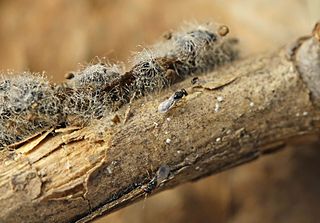
Chalcid wasps are insects within the superfamily Chalcidoidea, part of the order Hymenoptera. The superfamily contains some 22,500 known species, and an estimated total diversity of more than 500,000 species, meaning the vast majority have yet to be discovered and described. The name "chalcid" is often confused with the name "chalcidid", though the latter refers strictly to one constituent family, the Chalcididae, rather than the superfamily as a whole; accordingly, most recent publications (e.g.,) use the name "chalcidoid" when referring to members of the superfamily.

Whiteflies are Hemipterans that typically feed on the undersides of plant leaves. They comprise the family Aleyrodidae, the only family in the superfamily Aleyrodoidea. More than 1550 species have been described.
Afrotroppopsis is a monotypic genus of hymenopteran insects of the family Eulophidae.
Agmostigma is a small genus of hymenopteran insects of the family Eulophidae which contains three species, all described in 1996 by Ubaidillah and LaSalle and so far only recorded from Brunei in northern Borneo.
Aprostoporoides is a small Indomalayan genus of hymenopteran insects of the family Eulophidae which was described in 2004 with two newly described species from Kerala.
Chouioia is a genus of endoparasitic wasp of the family Eulophidae. Chouioia cunea is considered an important parasite of the fall webworm in China, where the moth is an invasive species.

Colpoclypeus is a genus of hymenopteran insects of the family Eulophidae.
Eprhopalotus is a genus of hymenopteran insects of the family Eulophidae. Their distribution varies between species but ranges from Costa Rica, Mexico to Texas. There are currently 5 species of Eprhopalotus:

Euplectrus is a genus of hymenopteran insects of the family Eulophidae.
Trisecodes is a genus of parasitic chalcid wasps of the family Systasidae. The genus was originally placed in Eulophidae, based on a number of morphological features, but molecular evidence suggests that the genus is more closely related to Systasis and Semiotellus. The type species is a parasitoid of a range of Agromyzid leaf-mining flies.

Aleurocanthus woglumi is a species of whitefly in the family Aleyrodidae. It is a pest of citrus crops, and is commonly known as the citrus blackfly because of its slate-blue colour. It originated in Asia, but has spread to other parts of the world. The parasitic wasps, Encarsia perplexa and Amitus hesperidum can help control the pest.

Encarsia perplexa is a tiny parasitic wasp, a parasitoid of the citrus blackfly, Aleurocanthus woglumi, which is a global pest of citrus trees. It was originally misidentified as Encarsia opulenta, but was recorded as a new species in 1998. It is a native of Asia but has been introduced to many other parts of the world as a means of controlling the citrus blackfly.

Encarsia is a large genus of minute parasitic wasps of the family Aphelinidae. The genus is very diverse with currently about 400 described species and worldwide distribution. The number of existing species is expected to be several times higher because many species are still undescribed. Encarsia is a very complex genus, with specimens showing both inter- and intra-specific variations, making morphological classification difficult.

Ablerus is the only genus in the family Azotidae. The genus was created by the American entomologist Leland Ossian Howard in 1894 for the species named in that year by William Harris Ashmead as Centrodora clisiocampae. The genus Azotus was synonymized with Ablerus by Alexandre Arsène Girault in 1913 and Hyatt synonymized Myocnemella with Ablerus in 1994, leaving Ablerus as the sole genus within the subfamily Azotinae. Azotinae was elevated in rank in 2013 to become the monotypic family Azotidae.
Encarsia inaron is a parasitoid wasp used in the control of ash whitefly, Siphoninus phillyreae. The ash whitefly is an insect from Europe that feeds on the sap of plants, and which has become a pest in North America. E. inaron was acquired from Italy and Israel and brought to California in 1989.

Encyrtinae is a subfamily of parasitic wasps in the family Encyrtidae.
Baeoentedon balios, the balios wasp, is a species of chalcid wasp which was first described from China in 2014. It is a parasitoid of whiteflies of the family Aleyrodidae.
John Stuart Noyes is a Welsh entomologist.
Baeoentedon bouceki is a species of wasp, one of the first three members of the genus Baeoentedon to be discovered in China. It is less than a millimetre in length, with a head slightly wider than the middle portion of the body. Only one specimen has been studied, collected from Hainan in 1983. As that specimen is female, the appearance of males is unknown.

Orchamoplatus citri, commonly known as the Australian citrus whitefly, is a whitefly species in the genus Orchamoplatus. It is found across Australia and New Zealand, primarily foraging on the leaves of citrus trees.








